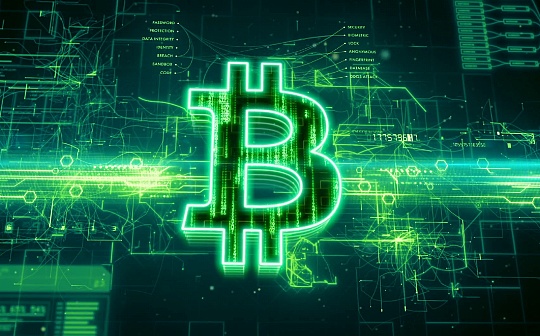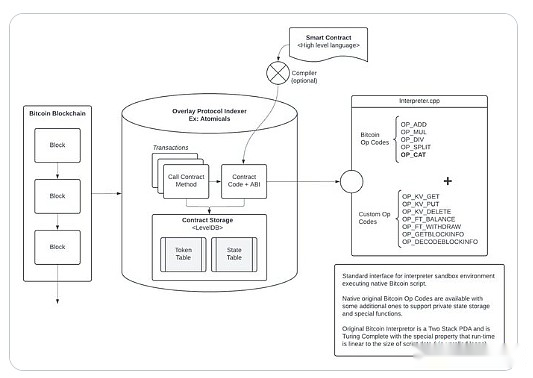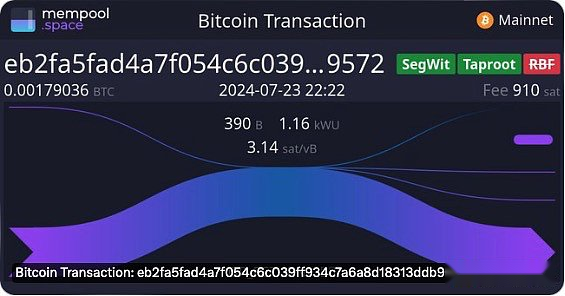
Author: Trustless Labs, Source: Author Twitter @TrustlessLabs
Since the first quarter of 2024, the speculative enthusiasm of the BTC ecosystem is not as good as in 2023, but as more and more developers join and become familiar with the BTC model, the technological progress of the BTC ecosystem is very rapid, especially in programmability.on the extension plan.Previously, Trustless labs introduced the binding of BTC’s L2 and UTXO and the re-staking of BTC. This article will continue to check for shortcomings and fill in the gaps and introduce the programmable solutions of BTC metadata protocols such as Fractal Bitcoin, which has a high level of attention, and BTC metadata protocols such as BRC20, CBRC, and ARC20.
1. Fractal
Fractal is a virtualization based on bitcoin core client software. By recursively creating a tree-like scalable framework, each layer of blockchain can improve the performance of the entire Fractal network.Because of reusing the main code, Fractal is instantly compatible with Bitcoin and its infrastructure, such as fully general in mining.The difference is that Fractal activates the op_cat operator, allowing more logic to be implemented.
Fractal was developed by the Unisat team, and Unisat mentioned the development progress of Fractal in its January 2024 blog.The project launched the Beta Test Network on June 1, 2024, and completed a test phase reset on July 29, and the main network is expected to be launched in September 2024.
The team has just released its token economics, and the Fractal network will have its own tokens, 50% produced by mining, 15% used for the ecosystem, 5% pre-sale to early investors, and 20% of consultants and core contributors, 10% of the community subsidy is used to establish partnerships and liquidity.
Architectural design
Fractal fully virtualizes the bitcoin core client, encapsulating it into a deployable and run blockchain software package (Bitcoin Core Software Package (BCSP).Then run one or more BCSP instances independently by recursively anchoring on the Bitcoin main network.Through modern virtualization technology, efficient hardware performance sharing is achieved, allowing multiple instances to run on the main system.Simply put, it is similar to opening multiple virtual machine instances (BCSP instances built by Fractal) on a computer (BTC mainnet), and it can also be recursive.
When a large number of on-chain interaction requirements arise, these requirements can be optionally delegated to a deeper level.The dynamic balance capability of this system helps avoid excessive congestion at any particular level.For a better user experience, Fractal has also made some modifications to bitcoin core. The block confirmation time is changed to 30 seconds or less, and the block size is increased by 20 times to 20 MB, which ensures sufficient performance andShort enough delay.
Fractal activates the op_cat operator, allowing more expansion schemes on BTC to explore and test.
At the asset collapse chain level, since different instances are running in a physical environment, it can be understood that multiple bitcoin core chains are run under the same BTC framework, so instance chains can communicate with each other, by constructing a common asset transfer interfaceto achieve seamless asset transfer between different layers.
Bitcoin and assets such as BRC-20 and Ordinals can be bridged through decentralization.The underlying mechanism is a rotating MPC signature mechanism with dynamic replacement.At present, it should be a layer of packaging.In subsequent iterations, BTC and other mainnet assets can also exist on Fractal Bitcoin as brc-20 packaging assets.

Compared with the typical Ethereum Layer 2 solution, this form of virtualization achieves computational scalability through additional abstraction layers outside the main chain while maintaining consistency with the main chain without introducing new consensus mechanisms.Therefore, the current BTC ASIC miners and mining pools can seamlessly join the Fractal network.
The security guarantee of Fractal lies in its computing power.In terms of design, the security of Fractal’s PoW mechanism is mainly enhanced through three aspects.Fractal introduced joint mining, one block in every three blocks is generated by combining mining with BTC miners to help protect the network from potential 51% attacks; the remaining two blocks are owned by the Fractal network.Computational power output.It can be seen that the impact on BTC miners is the key to Fractal’s success, and its token economy will inevitably tilt towards miners.
At the same time, the newly created virtualized instance chain will undergo an initial fragile period during the startup phase.When starting a new instance, the operator can set a specific block height to provide protection until the instance reaches a safe and healthy state.In the future, miners with a lot of computing power can allocate their resources to different BCSP instances, thereby enhancing the robustness and resilience of the entire system.
The relationship between Fractal main network coins and sats
The mining output of Fractal main network coins is to ensure the operation of the chain. The fb chain and btc are basically the same, and there is no ability to directly run smart contracts. Therefore, complex defi, such as swap functions, require additional infrastructure.Unisat promises to use brc20 sats for swap use. This swap runs on Fractal and also requires its own nodes. The service fees charged by these nodes for their own profit and loss are sats.
2. AVM
AVM (Atomicals Virtual Machine) is a BTC smart contract implementation of Atomicals Protocol.AVM creates a virtual machine that simulates the allowed by BTC scripts and opens multiple BTC original opcodes in the virtual machine. Developers implement smart contracts through a combination of Bitcoin scripts and define their own rules to manage the creation and transfer of assets.

Satoshi Nakamoto initially designed a fully expressive scripting language design in Bitcoin, which contains a rich set of original opcode instructions. These scripts have certain data storage capabilities and are executed in Turing-complete.Later, the Bitcoin core disabled some of the opcodes required for Turing completeness, such as basic string concatenation operations (OP_CAT) and arithmetic operators (such as multiplication OP_MUL and division OP_DIV).
The idea of AVM is to maximize the capabilities of BTC’s original opcode.The AVM virtual machine simulates BTC scripts and achieves Turing completeness through a dual-stack PDA (pressible storage automaton).This virtual machine runs in a sandbox, which contains an indexer, instruction parser, and global state, thereby realizing the synchronization and verification of smart contract processing and state.
The instruction set of the AVM virtual machine contains the complete BTC opcode, so developers can use many BTC functions to program on the main network.This makes AVM look like a native pioneer network for BTC ecosystem expansion.
AVM is a set of architectures. Any BTC metadata protocol, such as BRC20, ARC20, Runes, and CBRC, can be customized. It is managed by application developers, service providers and users, forming a spontaneous consensus..Therefore, it is suitable for almost any metadata protocol, and only fine-tuning of the indexer under the virtual machine is required.
AVM has released a beta version https://x.com/atomicalsxyz/status/1823901701033934975, and the relevant code https://github.com/atomicals/avm-interpreter.
3. OP_NET
Official website: https://opnet.org/#
OP_NET and proposed in the third quarter of 2024 are committed to introducing Ethereum-like smart contract functions on the Bitcoin network, but more in line with the characteristics and architecture of Bitcoin.Transactions on OP_NET are simply used with native Bitcoin, without using other tokens to pay for node incentives or transaction fees.
OP_NET provides a complete, compact and easy-to-use development library, written mainly in AssemblyScript (similar to TypeScript, which can be compiled into WebAssembly). Its design goal is to simplify the creation, reading and operation of Bitcoin-related technologies, especially in smartContracts and Bitcoin Smart Inscriptions (BSI, Bitcoin Smart Inscription).
Core functions and features of OP_NET
OP_NET retains Bitcoin’s block consensus and data availability, ensuring that all transactions are stored on the Bitcoin network and protected by its immutable protection.With an execution virtual machine (OP_VM), OP_NET can perform complex calculations on the Bitcoin block, all submitted OP_NET transactions are marked as “BSI” strings and executed in OP_VM to update the contract status.
The OP_NET node runs a WASM virtual machine, so it supports programming languages such as AssemblyScript, Rust and Python. By enabling advanced smart contract capabilities with Tapscript, developers can deploy and deploy directly on the Bitcoin blockchain without permission.Interactive smart contract.
The code of these smart contracts is compressed and written into BTC transactions.This time, a UTXO address is produced, which is considered a contract address. The user needs to transfer money to this address when interacting with the contract.
When interacting with the OP_NET network, in addition to removing the handling fee for BTC transactions, users also need to pay an additional handling fee of at least 330, which is to ensure that the transaction will not be recognized as a “dust attack” by BTC main network miners.Users can add more gas fees, and the packaging order of transactions in the OP_NET network will be sorted according to the handling fee, not entirely relying on the BTC block packaging order.If the user pays an OP_NET transaction fee greater than 250,000 sat, the excess will be rewarded for the OP_NET node network.
In order to extend the use of BTC in DeFi applications, OP_NET provides a Proof of Authority system, allowing BTC to be encapsulated as WBTC. The main network BTC is bridged into the OP_NET protocol through multi-signature.
It is worth mentioning that OP_NET is compatible with SegWit and Taproot, and its token design is not bound to UTXO, avoiding the risk of sending tokens incorrectly to miners, further improving the security and reliability of the system.Through these features, OP_NET injects stronger smart contract capabilities and decentralized application support into the Bitcoin ecosystem.
OP_NET’s Ecological Project
The predecessor of OP_NET was the cbrc-20 protocol, and most ecological projects were directly continued.The ecosystem covers many fields such as decentralized transactions, lending, market making, liquidity provision, cross-chain bridges, etc.:
· Motoswap: This is a decentralized transaction protocol that runs on Bitcoin Layer 1.
· Stash: This is a decentralized lending protocol that runs on Bitcoin Layer 1.Stash uses OP_NET’s WBTC as collateral, allowing users to borrow without permission, and loans are issued in USDs stablecoins.
· Ordinal Novus: This is a market-making and liquidity providing platform in the OP_NET ecosystem.
· Ichigai: This is a decentralized aggregator that integrates multiple DeFi platforms, allowing users to manage transactions, market tracking and portfolios on one interface.
· SatBot: A Telegram-integrated trading bot that enables users to execute transactions, track markets and manage portfolios in real time through Telegram.
· KittySwap: A decentralized exchange and perpetual contract platform running on OP_NET.
· Redacted: Provides private on-chain compliance DeFi private banking services.
· SLOHM Finance: A decentralized reserve currency project launched on OP_NET.
· BuyNet: Buy robot developed for the Bitcoin DeFi ecosystem.
· SatsX: A project that develops multi-function features and tools on OP_NET to expand the ecosystem’s capabilities.
· Meme Coins such as Satoshi Nakamoto Inu, Zyn, Unga, Pepe: These are Meme tokens based on the OP_20 protocol, and are all supported by OP_NET.
4. BRC100
Documentation: https://docs.brc100.org
BRC-100 is a decentralized computing protocol built based on Ordinals theory. By adding new operations such as “destruction” and “casting” to brc20, the combination of these new operations can record the held by different addresses in the indexer.Token balance and status, thereby achieving complex defi operations.Developers can also expand more operators based on the BRC-100 protocol to expand their business.
Operation of BRC-100 protocol
BRC-100 provides some operations: mint2/mint3 and burn2/burn3, allowing tokens to safely convert between UTXO models and state machine models:
mint2: Used to generate new tokens and will increase the circulation of the entire system.Permissions from an application or address are usually required to operate.
· mint3: Similar to mint2, but does not increase the flow.It is mainly used to convert balances in applications to UTXO (no transaction output spent), which can be used in other applications.
burn2: Used to destroy tokens and update the status of the application.Destroyed tokens can be regenerated through mint2 when certain conditions are met.
Burn3: Similar to burn2, but does not reduce circulation, but converts tokens to the state of the application.Destroyed tokens can be regenerated through mint3.
Extensions and compatibility
Computational power and state transitions can be extended by the BRC-100 extension protocol.All BRC-100 extension protocols are compatible with each other, that is, the tokens that implement BRC-100 and its extension protocols can be used in all applications.At the same time, the BRC-100 protocol and its extended protocol can be updated and upgraded through improved protocols.
The BRC-100 protocol and all its extended and improved protocols are collectively referred to as the BRC-100 protocol stack. All BRC-100 extension protocols are compatible with each other, that is, the tokens that implement the BRC-100 and its extended protocols can be used in all applications and support cross-borderChain operation.There are BRC-101, BRC-102 and BRC-104:
· BRC-101 is a decentralized on-chain governance protocol that defines how to manage applications based on the BRC-100 protocol or its extended protocol.
· BRC-102 is an automated liquidity protocol for BRC-100 assets. It defines an automated market-making method based on the “constant product formula” (x*y=k) for a pair of tokens based on the BRC-100 protocol stack.
BRC-104 is a liquid pledge/re-staking pool protocol that defines how to package BRC-20 assets, rune assets and BTC into BRC-100 assets through pledge, and how to allocate BRC-100 asset rewards to BRC-100 assets, BRC -20 types of assets, rune assets or BTC pledges.BRC-104 is the Asset Wrapping protocol and Yield Farming protocol of the BRC-100 protocol stack.
BRC-100 Ecological Project
The project party is exploring a method for implementing a minimum index for the BRC-100 protocol indexer.The demander can deploy its own minimum index to obtain the state of all assets of the BRC-100 protocol stack without implementing the complex computing logic of all extended protocols.Moreover, the minimum index does not require frequent updates or upgrades.
There are 3 projects in the BRC-100 ecosystem:
· inBRC (Launched) – The first BRC-100 market and indexer: https://inbrc.org.
· 100Swap (Launched) – The first Bitcoin L1 AMM inscription decentralized exchange based on the BRC-102 protocol: https://100swap.io.
· 100Layer (Developing) – Liquidity protocol for the Bitcoin ecosystem on Bitcoin L1, based on the BRC-104 protocol and the BRC-106 protocol, stablecoins, packaging tokens and liquidity mining supported by decentralized collateralComposition: https://100layer.io.
5. Programmable RUNES (Protorunes)
Runes are essentially a data structure stored in the OP_RETURN field of Bitcoin.Compared with other JSON-based protocols such as BRC-20, runes are lighter and do not rely on complex indexing systems, maintaining the simplicity and security of Bitcoin.
Programmable runes are extension layers of runes that allow the creation of programmable assets with runes.The introduction of these assets can exist in UTXO and supports operations similar to the AMM (Automatic Market Maker) protocol.The core concept of programmable runes is to use data on the Bitcoin blockchain to realize the functions of smart contracts through virtual machines or similar technologies.
Proto-Runes Protocol
Among programmable runes, the most important project is Proto-Runes Protocol, led by the team of @judoflexchop, the founder of the oyl wallet.Currently open source:https://github.com/kungfuflex/protorune
Proto-Runes Protocol is a standard and specification that provides a framework for programmable runes. By managing and transferring rune assets between sub-protocols, AMMs, lending protocols or mature smart contracts can be built.
For example, Proto-Runes Protocol implements Uniswap-like DEX (decentralized exchange) on the Bitcoin network, supporting the atomic exchange of rune assets and the creation of liquidity pools.Through the combination of prototype destruction and prototype messages, users can perform decentralized transactions and asset management without leaving the Bitcoin network.
Simply put, Proto-Runes Protocol allows runes to be Burn into the form of programmable runes Protorunes, thus giving runes additional functionality and uses.
Protoburn and Protorunes
One of the key mechanisms of Proto-Runes is Protoburn, which allows users to destroy and convert runes into representations that are only used by sub-protocols, which are targeted by Runestone’s pointer or dict (legal) on runes protocols., thereby generating a new asset form in the subprotocol, that is, programmable rune Protorunes.
Prototype destruction ensures that it is not cost-effective by locking the rune on the OP_RETURN output.This mechanism ensures that rune assets can be safely transferred from the master protocol to the sub-protocol, allowing further operations and transactions in the sub-protocol.
This process is usually one-way, where the assets are transferred from the rune protocol to the subprotocol, but cannot be directly transferred back.The Protoburn message is embedded in the Protostone in the Protocol field of Runestone, and its protocol label is 13 (Runes Protocol Label).The message contains information such as the target subprotocol ID and asset pointers.This mechanism provides the basis for asset management and transfer between sub-protocols and allows functions such as atomic swaps.
Protomessage
In the Proto-Runes protocol, Protomessage refers to the operation instructions executed in the subprotocol.It is implemented by encoding in the Protostone structure and parsing it by the indexer.Protomessage usually includes operational requests for assets, such as transfers, transactions, or other functions defined by the protocol.When the indexer parses to a message field in Protostone, the field contains an array of bytes, which is usually parsed by a serializer expected by protobuf or other subprotocols, and is then passed as a parameter to the runtime of the subprotos.This message may involve asset transfers, transaction logic, or other protocol functions.
Pointers are used to specify the target position of the Protostone, which can be one UTXO in the transaction output or another Protostone.If the sub-protocol decides not to execute an input, when the transaction fails, the protorunes will be returned to the position pointed to by the refund pointer (refund_pointer), and the unused assets will be returned to the initiator of the original transaction.
The operating mechanism of the Proto-Runes protocol
The operating mechanism of the Proto-Runes protocol is: the indexer first processes the Runestone feature in the rune protocol, and then processes the protocol messages of the sub-protocol in sequence.All Protostones are processed in the order in which they appear in the Protocol field of Runestone.To avoid complexity and potential security vulnerabilities, the Proto-Runes protocol prohibits recursive execution of prototype messages, that is, each prototype message can only be executed once, any recursive instructions will cause transaction failure, and unused assets will be returned.
In the Proto-Runes protocol, LEB128 (Little Endian Base 128) is a variable-length encoding method used to represent large integers.LEB128 encoding is widely used to represent protocol fields and messages to save space and improve processing efficiency.Each subprotocol has a unique protocol tag that distinguishes different subprotocols.These tags are represented by u128 values and appear in Protostone as LEB128 encoded values.Pointers are used to specify the target location of the Protostone, which can be a UTXO in the transaction output, or another Protostone, or even reference a prototype message to implement complex operational logic in the subprotos.
Latest progress: Creation Protorune
QUORUM•GENESIS•PROTORUNE is the first Protorrune. Its Protoburn has been successfully completed and you can see the correct operation of the ord indexer. Protoburn occurs without cenotaph because the balance of QUORUM•GENESIS•PROTORUNE is output by using OP_RETURN., you can see through this link: https://mempool.space/tx/eb2fa5fad4a7f054c6c039ff934c7a6a8d18313ddb9b8c9ed1e0bc01d3dc9572.

This Creation Protorune is implemented only as a reference and is not intended for sale.It is designed to serve as an open forum for Protorune standards and can be integrated into the protocol to provide governance capabilities for project tokens.
@judoflexchop team is still developing a WASM indexer for this genesis protorune: https://github.com/kungfuflex/quorumgenesisprotorune
This is a functional model that implements on-chain governance on Bitcoin L1. As an indexer, it allows users to generate voting tokens through protomessage, and runes of the same range in each proposal can only generate voting tokens once.The proposal is automatically executed after the quorum reaches, and users can also withdraw the vote by transferring the voting tokens to an unpaid address.The entire process ensures transparency and effectiveness of governance.








